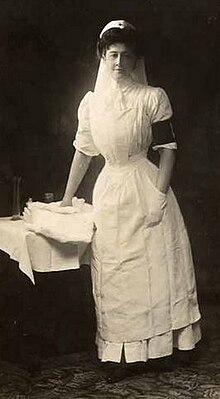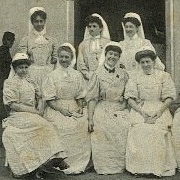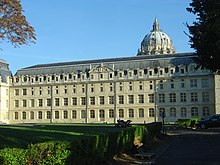Inès de Bourgoing
Inès-Marie de Bourgoing , also Inès Fortoul and Inès Lyautey , (born January 5, 1862 in Paris , France , † February 9, 1953 in Casablanca , French Morocco ) was a French nurse who was President of the French Red Cross and who Nursing established by the Red Cross in Morocco . In recognition of her extensive social work, she was the first woman to be awarded the Grand Cross of the Legion of Honor . She was also awarded the Grand Cross of Ouissam Alaouite for her work in French Morocco .
Born into a noble family , de Bourgoing was born at the court of Napoleon III. raised and married Joseph Fortoul, an artillery officer. Widowed at an early age, de Bourgoing, after raising her children, decided to devote herself to nursing in order to alleviate poverty, and took part in the first nursing courses offered in Paris. After starting to work as a nurse, she went to North Africa for the Société de Secours aux Blessés Militaires (SSBM), a forerunner of the French Red Cross: in 1907, she joined the SSBM and traveled to French Morocco to work in Casablanca to build a hospital. Fifteen months later, after the Messina earthquake , she was helping with disaster relief there.
In 1909 she married for the second time. Hubert Lyautey became the first French general resident for Morocco . De Bourgoing spent the rest of her life partly in France and partly in French Morocco, setting up hospitals, maternity clinics and child care institutions in both countries. She worked as hospital director in France during the two world wars and opened a soldiers' rest home in Salé and a retirement home for former members of the Foreign Legion near La Balme-les-Grottes . From 1926 to 1939 she was chairwoman of the women's committee of the SSBM, and when the three predecessor organizations were merged to form the French Red Cross in 1940, de Bourgoing became vice-president of the central committee of women of the French Red Cross. She later became director general of the organization. She worked until she was nine years old and remained active in French Morocco until her death in 1953. Her remains were later brought back to France.
Early life
Inès de Bourgoing was born in Paris on January 5, 1862, to Anne-Marie Léonie Dollfuss and Baron Philippe La Beaume de Bourgoing . Her mother was the maid of honor of the Empress Eugénie de Montijo , who was also the godmother of Inès de Bourgoing. The father was the grand stable master of France under Napoleon III. ; he was then inspector of the Haras Nationaux before he was elected five times for the constituency of Nièvre in the National Assembly. De Bourgoing attended the girls' school at the court in the Tuileries and in 1880, when she was 18 years old, she married the artillery captain Joseph Antoine Fortoul, with whom she had three children: Antoine (1881-1963), Mathieu (1882-1969) and Victoire (1887–1888), who died at the age of only 20 months.
Fortoul was often posted to serve in Japan and Southeast Asia; between 1882 and 1885 he was in Tonkin in Indochina , from where he returned seriously wounded. During his absence, de Bourgoing raised her two sons and wrote nearly 1,000 pages of letters to her husband, which are now kept in her archives. After his injury, Fortoul was stationed in Castres , where he commanded the 3rd Artillery Regiment, until his sudden death from a heart attack in 1900. When the two sons grew up and embarked on a military career, de Bourgoing decided to train as a nurse, to help alleviate disease and suffering in France's colonies. That year she entered the first nursing school to open in Paris and was a first-year student.
Career
After receiving her diploma in 1901, de Bourgoing joined the Société de Secours aux Blessés Militaires (SSBM) as a volunteer and began at the Hôpital Beaujon in Clichy near Paris. Because of her skills and understanding of both patients and physicians, she was called to the presidency of the SSBM. In 1907 she went to Morocco with the French expeditionary force under General Antoine Marius Benoît Drude . As the leader of a team of SSBM volunteers, she set up a hospital in Casablanca , where the wounded in the clashes between French and Moroccans were treated. Conditions on the ground were difficult and it was decided to move the injured and seriously ill to Oran, in what is now Algeria , where adequate care would be easier. In October 1907, she and two nurses accompanied the wounded on a French warship to Oran, where she first met General Hubert Lyautey , who was division commander there. After spending fifteen months in North Africa, she returned to the mother country , which she left a short time later for the Italian port city of Messina , where she and her nurses were involved in helping the injured and survivors of the Messina earthquake the effects of which in December 1908 died more than 80,000 people. The sisters of Princess Hélène d'Orléans were honored to recognize their achievements on site .

On October 14, 1909, de Bourgoing married General Lyautey in Paris. Both returned to Algeria, where Lyautey continued to be division commander until the couple returned to the motherland in 1910 and the general took command of the 10th Army Corps in Rennes . In 1912, the couple returned to North Africa, as Lyautey became the first French general resident after the Treaty of Fez , when Morocco became a French protectorate . De Bourgoing was instrumental in creating and organizing numerous programs for women and children, including children's homes, kindergartens and the first maternity homes in French Morocco, a role model institution that impressed child care professionals in France and beyond. She built clinics in rural areas, including the first tuberculosis clinics in the country and training programs for nurses. With the support of the SSBM, de Bourgoing also built the sanatorium in Salé near Rabat , which was used to relax French soldiers and soldiers of the Foreign Legion and their families, and a retirement home for soldiers of the Foreign Legion near La Balme-les-Grottes in the Isère department in metropolitan France . For this reason she received the rare title of Honorary Corporal of the Foreign Legion.
In 1915, de Bourgoing started an initiative to feed children in Casablanca . The goutte de lait worked as a milk bank and provided malnourished children and their parents with milk, later milk powder as well as education. Within five years, the initiative expanded its activities, built a center for the permanent care of premature babies and then facilities in Fez , Kenitra , Marrakech , Meknes , Mogador , Oujda , Rabat, Safi and Taza . During the First World War , de Bourgoing stayed in France, where she was director of the military hospital in Val-de-Grâce . In 1918 she organized and directed programs at the SSBM in Nancy . In 1921 the couple received the titles of Marshal and Marschallin of France .
In 1925 de Bourgoing returned to France with her husband, where they both spent their time in Paris and their ancestral home, Château de Thorey-Lyautey in Thorey-Lyautey in Lorraine . The following year she became president of the Central Committee of Women of the SSBM. In Thorey they built a hospital for families and a home for young people. After the death of her second husband in 1934, she divided her time between France and French Morocco. She was interested in helping the Moroccans in Paris and was involved in the improvement of the Muslim institute of the Grande Mosquée de Paris and the care of the sick at the Hôpital Avicienne in Bobigny, Seine-Saint-Denis, in the north of Paris. In Morocco she was involved in all committees, initiatives and meetings of the SSBM, but resigned from her functions in the mother country in 1938 in order to be able to spend more time in French Morocco.
In 1939 she took over the management of a military hospital for spinal and head injuries in Nancy. Because she was unable to leave France because of the Second World War , she initiated aid packages for troops and prisoners of war in North Africa. In August 1940 de Bourgoing agreed to become vice-president of the newly formed united French Red Cross. In the winter of 1944 she traveled to the front in the Vosges to support the 2nd Moroccan Infantry Division, which was involved in fierce fighting with the Germans. When the war ended, she resumed her travels to French Morocco, where she now spent several months each year. In 1946, de Bourgoing was appointed Directrice Générale de la Croix Rouge and was awarded the Grand Cross of the Legion of Honor, the first woman to receive this honor. She also received the Grand Cross of Ouissam Alaouite for her services in French Morocco .
recognition
There was widespread recognition for de Bourgoing's merits, but none was clearer than that of the French Foreign Minister Édouard Bonnefous , which he made on behalf of the French government on the occasion of her funeral on February 12, 1953 in Rabat. Addressing her as La Maréchale Lyautey , the minister highlighted how her work as a nurse in Morocco had contributed so much to France's humanitarian reputation thanks to the way in which she had sought to create a bond between the two countries. Through her work in caring for wounded soldiers and helping those in need regardless of race, gender, or belief, she won the admiration of those who gathered in Rabat and Casablanca for the Remembrance Days. France's gratitude found expression in de Bourgoings' award with the Grand Cross of the Legion of Honor as the first woman to receive this award.
Colonel Pierre Geoffroy, an employee of the Lyauteys, described her as a "great lady" whose little-known contributions to humanitarian work are only slowly coming into the public eye and so are her pioneering activities in the early 20th century in the field of social work and humanitarian aid reveal across borders.
Death and legacy
Inès de Bourgoing died on February 9, 1953 in Casablanca and was buried on February 12, 1953 in the mausoleum of Marshal Lyautey in Rabat. When the marshal's remains were transferred to metropolitan France in 1961, de Bourgoing was reburied in the Thorey-Lyautey cemetery at the request of the community .
On July 7, 2002, the 140th anniversary of de Bourgoing's birth, Senator Philippe de Bourgoing and Pierre de Bourgoing opened a small area on the first floor of the Château de Thorey-Lyautey to commemorate Inès de Bourgoing. Photographs and other historical artifacts are displayed here. The rest of the building is dedicated to the life of her husband Hubert Lyautey.
In 2014, the French Red Cross opened the Inès Lyautey Center in Paris to help homeless women. The center provides women with essential food, clothing, medical assistance and help with applying for jobs. In 2015, Goutte de Lait celebrated its hundredth birthday in Casablanca.
supporting documents
- ↑ a b c d biography de Mme Lyautey. In: Lyautey Mosaique Informatique 2007, p. 1.
- ^ A b Barnett Singer, John W. Langdon: Cultured Force: Makers and Defenders of the French Colonial Empire. 2008, p. 200 ( books.google.com ).
- ^ A b c Barnett Singer, John W. Langdon: Cultured Force: Makers and Defenders of the French Colonial Empire. 2008, p. 199 ( books.google.com ).
- ^ A b c Colonel Pierre Geoffroy: Madame la Maréchale Inès Lyautey et ses actions sanitaires. In: Réflexions. July 2012, p. 1.
- ↑ a b c d Center d'hébergement d'urgence Inès Lyautey réservé aux jeunes femmes. Croix-Rouge Française, December 15, 2014, archived from the original on March 24, 2015 ; Retrieved September 25, 2016 (French, Paris).
- ↑ a b c d Pierre Bourget: Infirmière militaire et… Maréchale de France, Inès de Bourgoing . In: Professions Santé Infirmier Infirmière . No. 38 (June-July). Edimark, 2002, ISSN 1290-9769 , p. 52 (French, edimark.fr [PDF; accessed September 24, 2016]). edimark.fr ( Memento of the original from March 4, 2016 in the Internet Archive ) Info: The archive link was inserted automatically and has not yet been checked. Please check the original and archive link according to the instructions and then remove this notice.
- ^ General de Drude Division. Musée des Etoiles, Musée des Officiers Généraux Français Armes & Services (Museum of French Generals Weapons & Services), March 8, 2015, archived from the original on September 24, 2016 ; Retrieved September 24, 2016 (French).
- ↑ Barnett Singer, John W. Langdon: Cultured Force: Makers and Defenders of the French Colonial Empire. 2008, p. 201 ( books.google.com ).
- ↑ Barnett Singer, John W. Langdon: Cultured Force: Makers and Defenders of the French Colonial Empire. 2008, p. 202 ( books.google.com ).
- ^ A b c Colonel Pierre Geoffroy: Madame la Maréchale Inès Lyautey et ses actions sanitaires. In: Réflexions. July 2012, p. 2.
- ↑ a b biography de Mme Lyautey. In: Lyautey Mosaique Informatique 2007, p. 3.
- ^ Haj Driss Benjelloun: L'œuvre de la Goutte de Lait. (PDF) Le Collectif des Psychologues Praticiens du Maroc (The Collective of Psychologist Practitioners of Morocco), April 3, 2015, accessed on September 26, 2016 (French, Casablanca, Morocco).
- ↑ a b Ouardirhi Abdelaziz: 100 ans de bons et loyaux services . Albayane Press, Casablanca, Morocco April 3, 2015 (French, albayane.press.ma ( September 26, 2016 memento in the Internet Archive ) [accessed September 26, 2016]).
- ↑ Jules Colombani, Dr. Mauran: Le Ministère de la santé et de l'hygiene publiques au Maroc . Ed .: Le Ministére de la Santé et de l'Hygiéne Publiques. Rabat, Morocco 1923, p. 20 (French, archive.org ).
- ^ Maternity et protection de l'enfance . In: Maroc Soir . Casablanca, Morocco July 28, 2006, p. 17 (French, lyceelyautey.org [PDF; accessed September 26, 2016]). lyceelyautey.org ( Memento of the original from January 23, 2017 in the Internet Archive ) Info: The archive link was inserted automatically and has not yet been checked. Please check the original and archive link according to the instructions and then remove this notice.
- ↑ Barnett Singer, John W. Langdon: Cultured Force: Makers and Defenders of the French Colonial Empire. 2008, p. 208 ( books.google.com ).
- ^ A b Pierre Geoffroy: La Maréchale Lyautey. mémoire d'Afrique du Nord, 2011, archived from the original on November 28, 2012 ; Retrieved September 26, 2016 (French).
- ↑ a b c d biography de Mme Lyautey. In: Lyautey Mosaique Informatique 2007, p. 4.
- ^ A b Frédéric Pineau: 8 Questions a: Marie-Jose Chavenon pour son livre Ines Lyautey. In: Françaises sous l'uniforme, 1852–1993. Femmes en Uniforme, September 19, 2013, accessed September 24, 2016 (French, Paris).
- ↑ A la rencontre d'Inès Lyautey. Livres Critique, March 28, 2011, accessed September 29, 2016 (French).
- ↑ Inès Lyautey, Línfirmière, la Maréchale. Le choix des libraires, November 6, 2010, accessed September 29, 2016 (French, Paris).
- ↑ Édouard Bonnefous: Homage à la Maréchale Lyautey. In: Revue des deux mondes. February 12, 1953, accessed September 26, 2016 (French).
- ^ Geoffroy Pierre. Magistro, accessed September 26, 2016 (French).
- ↑ Biography of Mme Lyautey. In: Lyautey Mosaique Informatique. Association nationale Maréchal Lyautey (National Association of Marshal Lyautey), 2007, p. 6 , archived from the original on October 12, 2007 ; Retrieved September 24, 2016 (French, Chateau de Thorey-Lyautey, France).
literature
- Marcelle Antoine-Drapier: Madame Lyautey (1862-1953) . Association Nationale Maréchal Lyautey, Reims 2001 (French).
- Barnett Singer, John W. Langdon: Cultured Force: Makers and Defenders of the French Colonial Empire . University of Wisconsin Press, Madison, Wisconsin 2008, ISBN 978-0-299-19904-3 , pp. 199-208 ( books.google.com ).
- Colonel Pierre Geoffroy: Madame la Maréchale Inès Lyautey et ses actions sanitaires . In: Le Club Professeurs de la Faculté de Médecine de Nancy, University of Lorraine (ed.): Réflexions . Nancy July 2012, p. 1–2 (French, cph.medecine.univ-lorraine.fr [PDF; accessed September 24, 2016]).
- Marie-José Chavenon: Ines Lyautey: L'infirmière, la maréchale . Gérard Louis Editeur, Haroué 2010, ISBN 978-2-914554-97-8 (French).
Web links
- Biography de Mme Lyautey. In: Lyautey Mosaique Informatique. Association nationale Maréchal Lyautey (National Association of Marshal Lyautey), 2007, archived from the original on October 12, 2007 ; Retrieved September 24, 2016 (French, Chateau de Thorey-Lyautey, France).
| personal data | |
|---|---|
| SURNAME | Bourgoing, Inès de |
| ALTERNATIVE NAMES | Bourgoing, Inès-Marie de (full name); Fortoul, Inès; Lyautey, Inès |
| BRIEF DESCRIPTION | french nurse |
| DATE OF BIRTH | January 5, 1862 |
| PLACE OF BIRTH | Paris , France |
| DATE OF DEATH | February 9, 1953 |
| Place of death | Casablanca , French Morocco |



